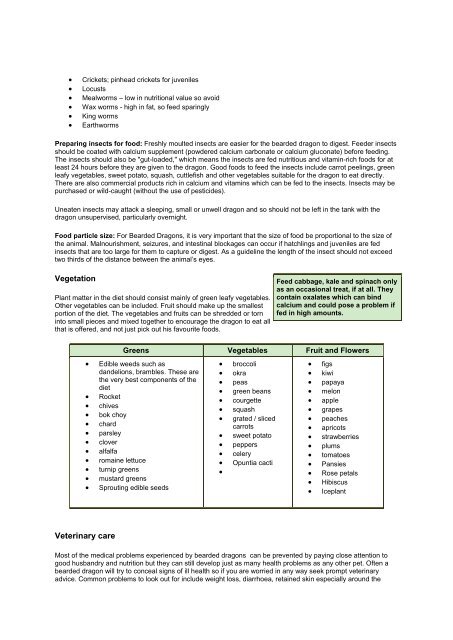Bearded Dragon Care Sheet - Shires Veterinary Practice
Bearded Dragon Care Sheet - Shires Veterinary Practice
Bearded Dragon Care Sheet - Shires Veterinary Practice
Create successful ePaper yourself
Turn your PDF publications into a flip-book with our unique Google optimized e-Paper software.
Crickets; pinhead crickets for juveniles<br />
Locusts<br />
Mealworms – low in nutritional value so avoid<br />
Wax worms - high in fat, so feed sparingly<br />
King worms<br />
Earthworms<br />
Preparing insects for food: Freshly moulted insects are easier for the bearded dragon to digest. Feeder insects<br />
should be coated with calcium supplement (powdered calcium carbonate or calcium gluconate) before feeding.<br />
The insects should also be "gut-loaded," which means the insects are fed nutritious and vitamin-rich foods for at<br />
least 24 hours before they are given to the dragon. Good foods to feed the insects include carrot peelings, green<br />
leafy vegetables, sweet potato, squash, cuttlefish and other vegetables suitable for the dragon to eat directly.<br />
There are also commercial products rich in calcium and vitamins which can be fed to the insects. Insects may be<br />
purchased or wild-caught (without the use of pesticides).<br />
Uneaten insects may attack a sleeping, small or unwell dragon and so should not be left in the tank with the<br />
dragon unsupervised, particularly overnight.<br />
Food particle size: For <strong>Bearded</strong> <strong>Dragon</strong>s, it is very important that the size of food be proportional to the size of<br />
the animal. Malnourishment, seizures, and intestinal blockages can occur if hatchlings and juveniles are fed<br />
insects that are too large for them to capture or digest. As a guideline the length of the insect should not exceed<br />
two thirds of the distance between the animal’s eyes.<br />
Vegetation<br />
Plant matter in the diet should consist mainly of green leafy vegetables.<br />
Other vegetables can be included. Fruit should make up the smallest<br />
portion of the diet. The vegetables and fruits can be shredded or torn<br />
into small pieces and mixed together to encourage the dragon to eat all<br />
that is offered, and not just pick out his favourite foods.<br />
Greens Vegetables Fruit and Flowers<br />
Edible weeds such as<br />
dandelions, brambles. These are<br />
the very best components of the<br />
diet<br />
Rocket<br />
chives<br />
bok choy<br />
chard<br />
parsley<br />
clover<br />
alfalfa<br />
romaine lettuce<br />
turnip greens<br />
mustard greens<br />
Sprouting edible seeds<br />
<strong>Veterinary</strong> care<br />
broccoli<br />
okra<br />
peas<br />
green beans<br />
courgette<br />
squash<br />
grated / sliced<br />
carrots<br />
sweet potato<br />
peppers<br />
celery<br />
Opuntia cacti<br />
<br />
Feed cabbage, kale and spinach only<br />
as an occasional treat, if at all. They<br />
contain oxalates which can bind<br />
calcium and could pose a problem if<br />
fed in high amounts.<br />
figs<br />
kiwi<br />
papaya<br />
melon<br />
apple<br />
grapes<br />
peaches<br />
apricots<br />
strawberries<br />
plums<br />
tomatoes<br />
Pansies<br />
Rose petals<br />
Hibiscus<br />
Iceplant<br />
Most of the medical problems experienced by bearded dragons can be prevented by paying close attention to<br />
good husbandry and nutrition but they can still develop just as many health problems as any other pet. Often a<br />
bearded dragon will try to conceal signs of ill health so if you are worried in any way seek prompt veterinary<br />
advice. Common problems to look out for include weight loss, diarrhoea, retained skin especially around the


